Project Report: Quantitative Analysis of Employee Turnover in the UK
VerifiedAdded on 2023/06/12
|12
|2733
|463
Report
AI Summary
This report provides a quantitative analysis of the rising issue of high employee turnover in the UK, particularly after the onset of COVID-19. It reviews literature on the costs and causes of employee turnover, including decreased productivity, increased operational costs, and factors like lack of communication, unhealthy company culture, and ineffective retention policies. The analysis utilizes data from the Office of National Statistics (ONS), focusing on labor market statistics, weekly estimates, the impact of coronavirus on payroll employment, unemployment rates by nationality, and staff retention in the public sector. Key findings include the impact of COVID-19 on employment rates, shifts in economic inactivity, and challenges in staff retention within the public sector due to lack of motivation and ineffective employee engagement strategies. The report concludes that employee turnover is a significant issue in the UK, evidenced by rising unemployment rates and absenteeism, highlighting the need for improved employee retention strategies.
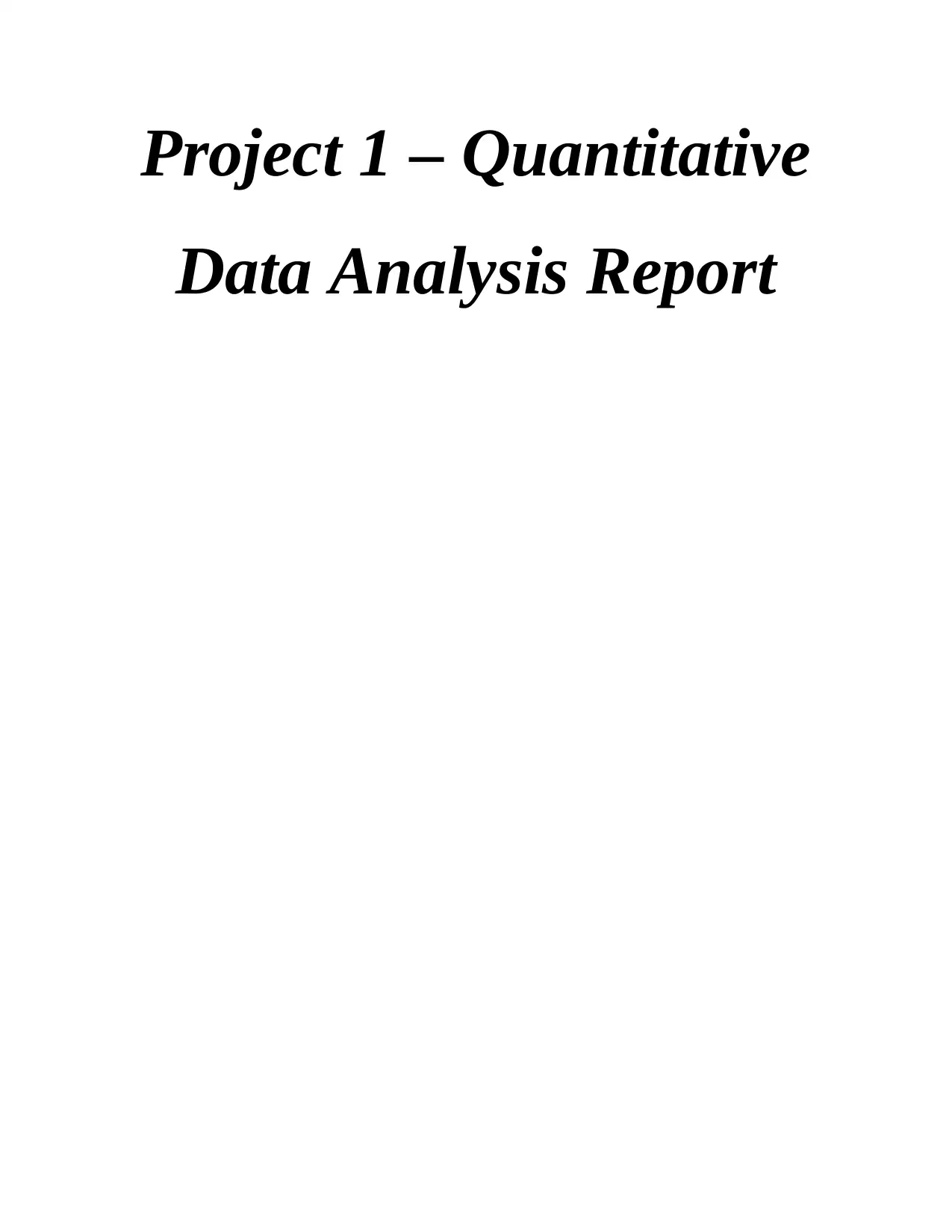
Project 1 – Quantitative
Data Analysis Report
Data Analysis Report
Paraphrase This Document
Need a fresh take? Get an instant paraphrase of this document with our AI Paraphraser
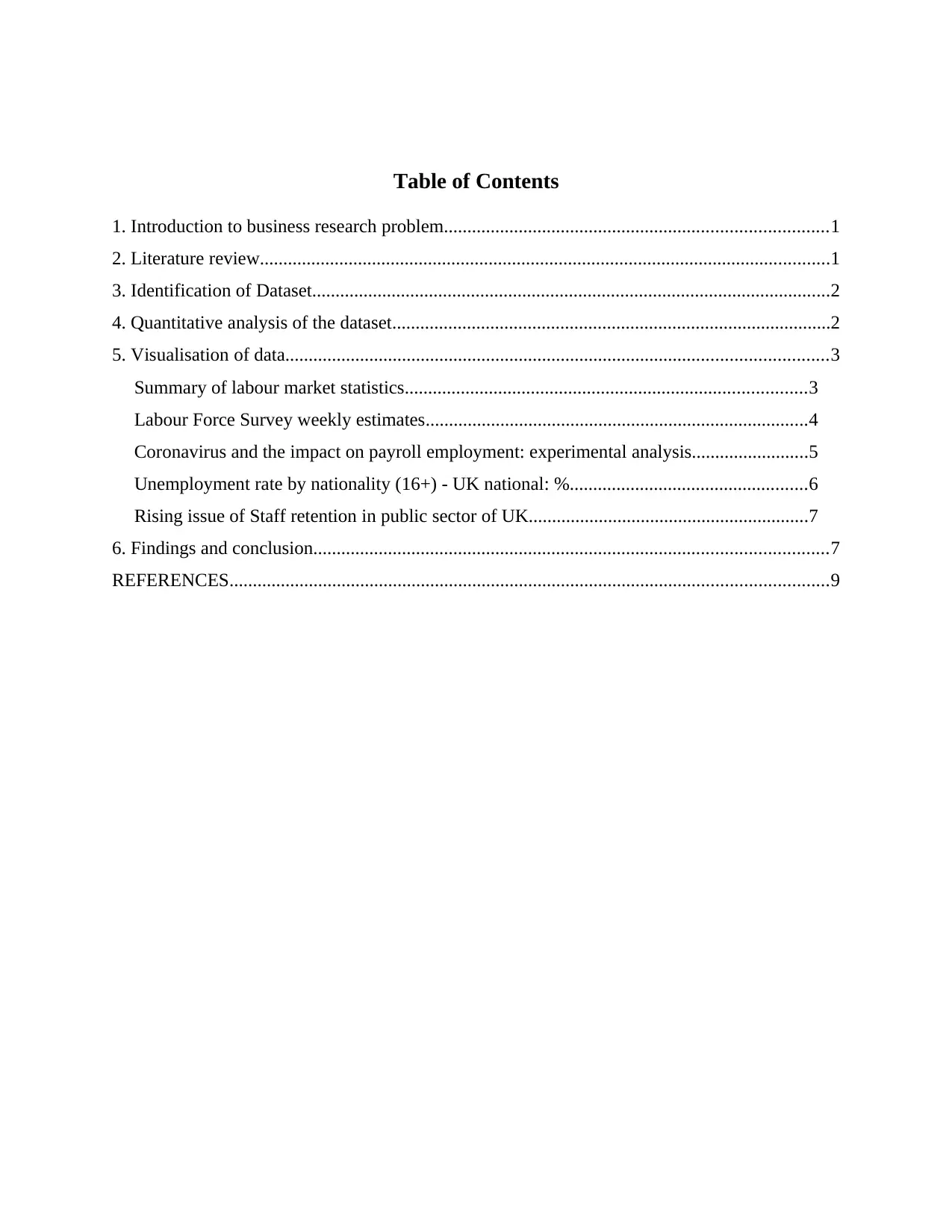
Table of Contents
1. Introduction to business research problem..................................................................................1
2. Literature review..........................................................................................................................1
3. Identification of Dataset...............................................................................................................2
4. Quantitative analysis of the dataset..............................................................................................2
5. Visualisation of data....................................................................................................................3
Summary of labour market statistics......................................................................................3
Labour Force Survey weekly estimates..................................................................................4
Coronavirus and the impact on payroll employment: experimental analysis.........................5
Unemployment rate by nationality (16+) - UK national: %...................................................6
Rising issue of Staff retention in public sector of UK............................................................7
6. Findings and conclusion..............................................................................................................7
REFERENCES................................................................................................................................9
1. Introduction to business research problem..................................................................................1
2. Literature review..........................................................................................................................1
3. Identification of Dataset...............................................................................................................2
4. Quantitative analysis of the dataset..............................................................................................2
5. Visualisation of data....................................................................................................................3
Summary of labour market statistics......................................................................................3
Labour Force Survey weekly estimates..................................................................................4
Coronavirus and the impact on payroll employment: experimental analysis.........................5
Unemployment rate by nationality (16+) - UK national: %...................................................6
Rising issue of Staff retention in public sector of UK............................................................7
6. Findings and conclusion..............................................................................................................7
REFERENCES................................................................................................................................9
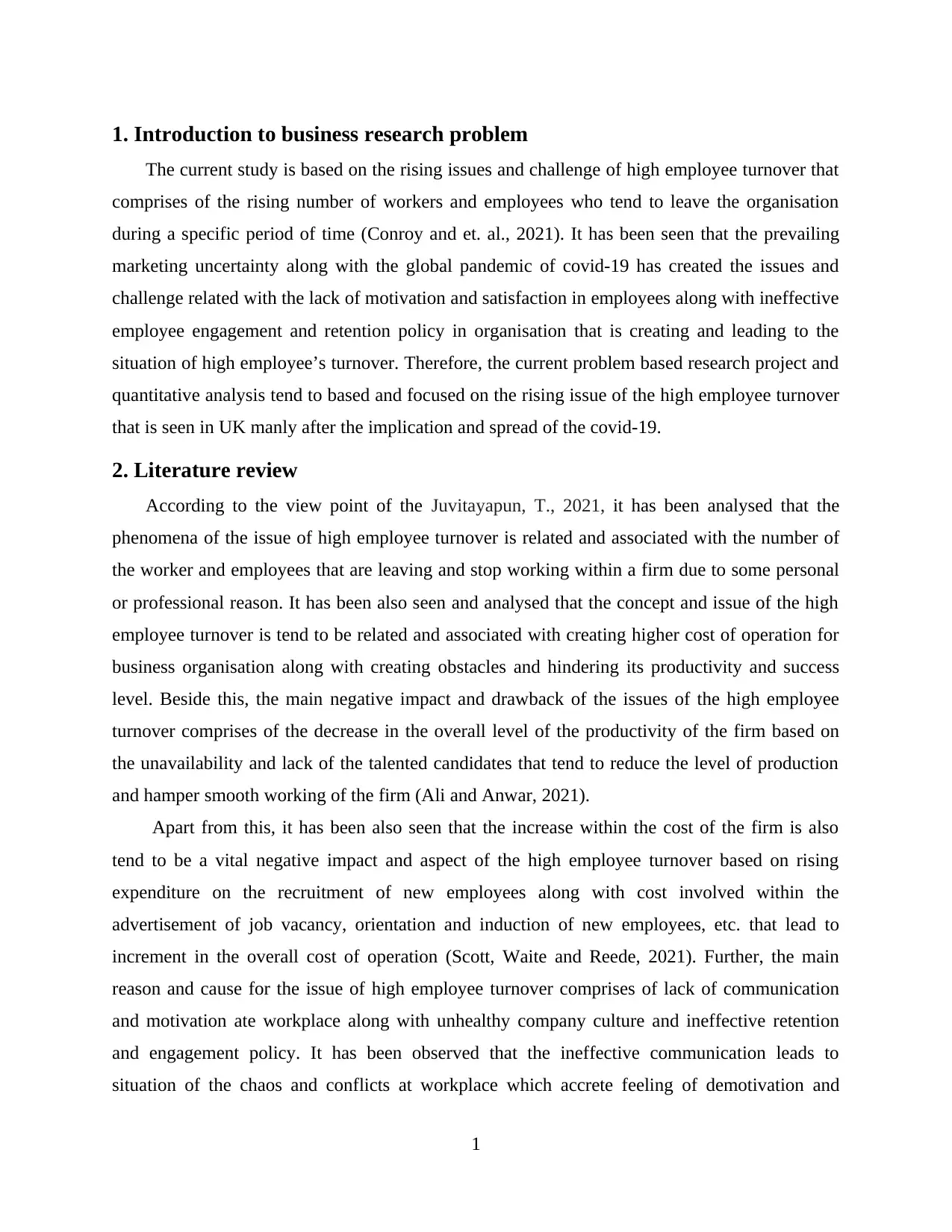
1. Introduction to business research problem
The current study is based on the rising issues and challenge of high employee turnover that
comprises of the rising number of workers and employees who tend to leave the organisation
during a specific period of time (Conroy and et. al., 2021). It has been seen that the prevailing
marketing uncertainty along with the global pandemic of covid-19 has created the issues and
challenge related with the lack of motivation and satisfaction in employees along with ineffective
employee engagement and retention policy in organisation that is creating and leading to the
situation of high employee’s turnover. Therefore, the current problem based research project and
quantitative analysis tend to based and focused on the rising issue of the high employee turnover
that is seen in UK manly after the implication and spread of the covid-19.
2. Literature review
According to the view point of the Juvitayapun, T., 2021, it has been analysed that the
phenomena of the issue of high employee turnover is related and associated with the number of
the worker and employees that are leaving and stop working within a firm due to some personal
or professional reason. It has been also seen and analysed that the concept and issue of the high
employee turnover is tend to be related and associated with creating higher cost of operation for
business organisation along with creating obstacles and hindering its productivity and success
level. Beside this, the main negative impact and drawback of the issues of the high employee
turnover comprises of the decrease in the overall level of the productivity of the firm based on
the unavailability and lack of the talented candidates that tend to reduce the level of production
and hamper smooth working of the firm (Ali and Anwar, 2021).
Apart from this, it has been also seen that the increase within the cost of the firm is also
tend to be a vital negative impact and aspect of the high employee turnover based on rising
expenditure on the recruitment of new employees along with cost involved within the
advertisement of job vacancy, orientation and induction of new employees, etc. that lead to
increment in the overall cost of operation (Scott, Waite and Reede, 2021). Further, the main
reason and cause for the issue of high employee turnover comprises of lack of communication
and motivation ate workplace along with unhealthy company culture and ineffective retention
and engagement policy. It has been observed that the ineffective communication leads to
situation of the chaos and conflicts at workplace which accrete feeling of demotivation and
1
The current study is based on the rising issues and challenge of high employee turnover that
comprises of the rising number of workers and employees who tend to leave the organisation
during a specific period of time (Conroy and et. al., 2021). It has been seen that the prevailing
marketing uncertainty along with the global pandemic of covid-19 has created the issues and
challenge related with the lack of motivation and satisfaction in employees along with ineffective
employee engagement and retention policy in organisation that is creating and leading to the
situation of high employee’s turnover. Therefore, the current problem based research project and
quantitative analysis tend to based and focused on the rising issue of the high employee turnover
that is seen in UK manly after the implication and spread of the covid-19.
2. Literature review
According to the view point of the Juvitayapun, T., 2021, it has been analysed that the
phenomena of the issue of high employee turnover is related and associated with the number of
the worker and employees that are leaving and stop working within a firm due to some personal
or professional reason. It has been also seen and analysed that the concept and issue of the high
employee turnover is tend to be related and associated with creating higher cost of operation for
business organisation along with creating obstacles and hindering its productivity and success
level. Beside this, the main negative impact and drawback of the issues of the high employee
turnover comprises of the decrease in the overall level of the productivity of the firm based on
the unavailability and lack of the talented candidates that tend to reduce the level of production
and hamper smooth working of the firm (Ali and Anwar, 2021).
Apart from this, it has been also seen that the increase within the cost of the firm is also
tend to be a vital negative impact and aspect of the high employee turnover based on rising
expenditure on the recruitment of new employees along with cost involved within the
advertisement of job vacancy, orientation and induction of new employees, etc. that lead to
increment in the overall cost of operation (Scott, Waite and Reede, 2021). Further, the main
reason and cause for the issue of high employee turnover comprises of lack of communication
and motivation ate workplace along with unhealthy company culture and ineffective retention
and engagement policy. It has been observed that the ineffective communication leads to
situation of the chaos and conflicts at workplace which accrete feeling of demotivation and
1
⊘ This is a preview!⊘
Do you want full access?
Subscribe today to unlock all pages.

Trusted by 1+ million students worldwide
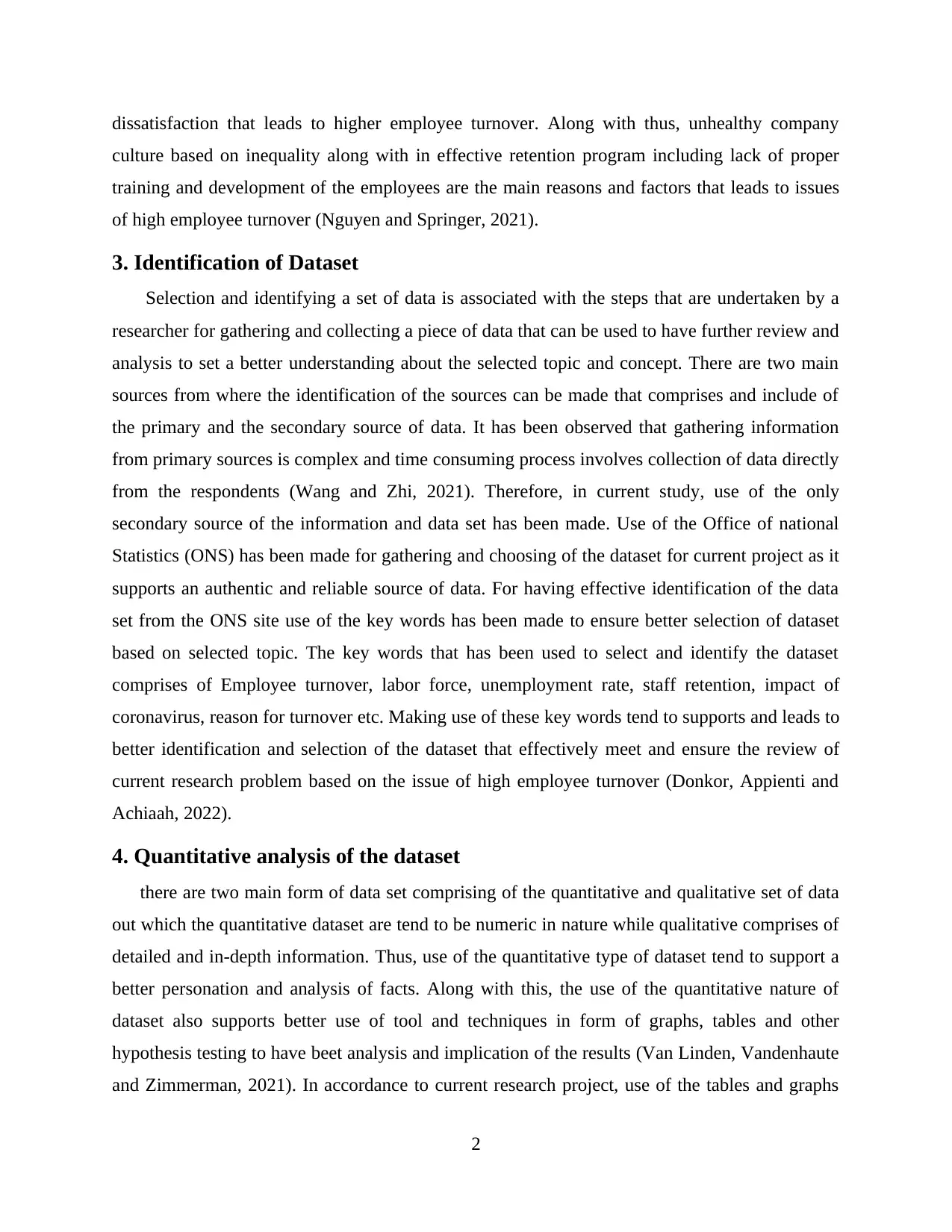
dissatisfaction that leads to higher employee turnover. Along with thus, unhealthy company
culture based on inequality along with in effective retention program including lack of proper
training and development of the employees are the main reasons and factors that leads to issues
of high employee turnover (Nguyen and Springer, 2021).
3. Identification of Dataset
Selection and identifying a set of data is associated with the steps that are undertaken by a
researcher for gathering and collecting a piece of data that can be used to have further review and
analysis to set a better understanding about the selected topic and concept. There are two main
sources from where the identification of the sources can be made that comprises and include of
the primary and the secondary source of data. It has been observed that gathering information
from primary sources is complex and time consuming process involves collection of data directly
from the respondents (Wang and Zhi, 2021). Therefore, in current study, use of the only
secondary source of the information and data set has been made. Use of the Office of national
Statistics (ONS) has been made for gathering and choosing of the dataset for current project as it
supports an authentic and reliable source of data. For having effective identification of the data
set from the ONS site use of the key words has been made to ensure better selection of dataset
based on selected topic. The key words that has been used to select and identify the dataset
comprises of Employee turnover, labor force, unemployment rate, staff retention, impact of
coronavirus, reason for turnover etc. Making use of these key words tend to supports and leads to
better identification and selection of the dataset that effectively meet and ensure the review of
current research problem based on the issue of high employee turnover (Donkor, Appienti and
Achiaah, 2022).
4. Quantitative analysis of the dataset
there are two main form of data set comprising of the quantitative and qualitative set of data
out which the quantitative dataset are tend to be numeric in nature while qualitative comprises of
detailed and in-depth information. Thus, use of the quantitative type of dataset tend to support a
better personation and analysis of facts. Along with this, the use of the quantitative nature of
dataset also supports better use of tool and techniques in form of graphs, tables and other
hypothesis testing to have beet analysis and implication of the results (Van Linden, Vandenhaute
and Zimmerman, 2021). In accordance to current research project, use of the tables and graphs
2
culture based on inequality along with in effective retention program including lack of proper
training and development of the employees are the main reasons and factors that leads to issues
of high employee turnover (Nguyen and Springer, 2021).
3. Identification of Dataset
Selection and identifying a set of data is associated with the steps that are undertaken by a
researcher for gathering and collecting a piece of data that can be used to have further review and
analysis to set a better understanding about the selected topic and concept. There are two main
sources from where the identification of the sources can be made that comprises and include of
the primary and the secondary source of data. It has been observed that gathering information
from primary sources is complex and time consuming process involves collection of data directly
from the respondents (Wang and Zhi, 2021). Therefore, in current study, use of the only
secondary source of the information and data set has been made. Use of the Office of national
Statistics (ONS) has been made for gathering and choosing of the dataset for current project as it
supports an authentic and reliable source of data. For having effective identification of the data
set from the ONS site use of the key words has been made to ensure better selection of dataset
based on selected topic. The key words that has been used to select and identify the dataset
comprises of Employee turnover, labor force, unemployment rate, staff retention, impact of
coronavirus, reason for turnover etc. Making use of these key words tend to supports and leads to
better identification and selection of the dataset that effectively meet and ensure the review of
current research problem based on the issue of high employee turnover (Donkor, Appienti and
Achiaah, 2022).
4. Quantitative analysis of the dataset
there are two main form of data set comprising of the quantitative and qualitative set of data
out which the quantitative dataset are tend to be numeric in nature while qualitative comprises of
detailed and in-depth information. Thus, use of the quantitative type of dataset tend to support a
better personation and analysis of facts. Along with this, the use of the quantitative nature of
dataset also supports better use of tool and techniques in form of graphs, tables and other
hypothesis testing to have beet analysis and implication of the results (Van Linden, Vandenhaute
and Zimmerman, 2021). In accordance to current research project, use of the tables and graphs
2
Paraphrase This Document
Need a fresh take? Get an instant paraphrase of this document with our AI Paraphraser
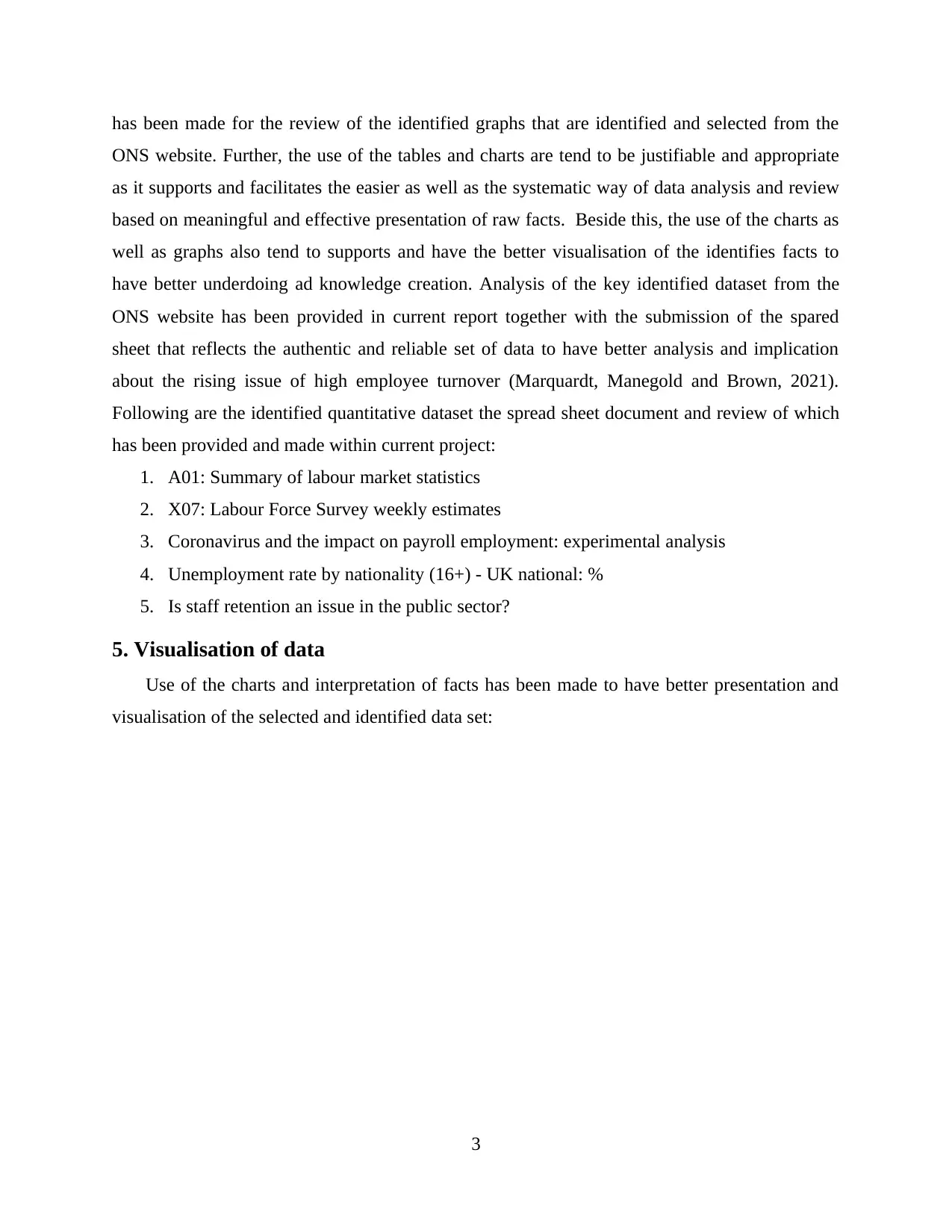
has been made for the review of the identified graphs that are identified and selected from the
ONS website. Further, the use of the tables and charts are tend to be justifiable and appropriate
as it supports and facilitates the easier as well as the systematic way of data analysis and review
based on meaningful and effective presentation of raw facts. Beside this, the use of the charts as
well as graphs also tend to supports and have the better visualisation of the identifies facts to
have better underdoing ad knowledge creation. Analysis of the key identified dataset from the
ONS website has been provided in current report together with the submission of the spared
sheet that reflects the authentic and reliable set of data to have better analysis and implication
about the rising issue of high employee turnover (Marquardt, Manegold and Brown, 2021).
Following are the identified quantitative dataset the spread sheet document and review of which
has been provided and made within current project:
1. A01: Summary of labour market statistics
2. X07: Labour Force Survey weekly estimates
3. Coronavirus and the impact on payroll employment: experimental analysis
4. Unemployment rate by nationality (16+) - UK national: %
5. Is staff retention an issue in the public sector?
5. Visualisation of data
Use of the charts and interpretation of facts has been made to have better presentation and
visualisation of the selected and identified data set:
3
ONS website. Further, the use of the tables and charts are tend to be justifiable and appropriate
as it supports and facilitates the easier as well as the systematic way of data analysis and review
based on meaningful and effective presentation of raw facts. Beside this, the use of the charts as
well as graphs also tend to supports and have the better visualisation of the identifies facts to
have better underdoing ad knowledge creation. Analysis of the key identified dataset from the
ONS website has been provided in current report together with the submission of the spared
sheet that reflects the authentic and reliable set of data to have better analysis and implication
about the rising issue of high employee turnover (Marquardt, Manegold and Brown, 2021).
Following are the identified quantitative dataset the spread sheet document and review of which
has been provided and made within current project:
1. A01: Summary of labour market statistics
2. X07: Labour Force Survey weekly estimates
3. Coronavirus and the impact on payroll employment: experimental analysis
4. Unemployment rate by nationality (16+) - UK national: %
5. Is staff retention an issue in the public sector?
5. Visualisation of data
Use of the charts and interpretation of facts has been made to have better presentation and
visualisation of the selected and identified data set:
3
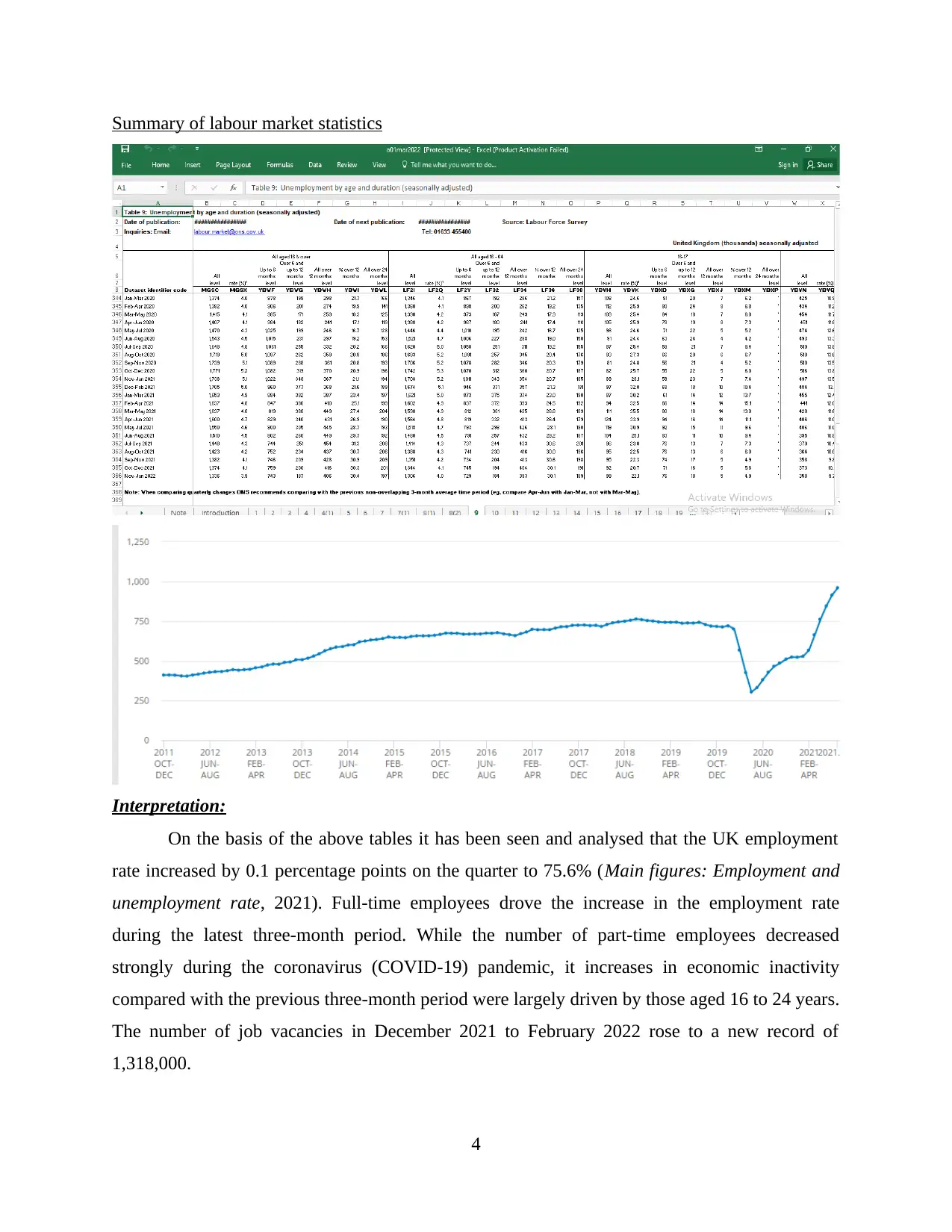
Summary of labour market statistics
Interpretation:
On the basis of the above tables it has been seen and analysed that the UK employment
rate increased by 0.1 percentage points on the quarter to 75.6% (Main figures: Employment and
unemployment rate, 2021). Full-time employees drove the increase in the employment rate
during the latest three-month period. While the number of part-time employees decreased
strongly during the coronavirus (COVID-19) pandemic, it increases in economic inactivity
compared with the previous three-month period were largely driven by those aged 16 to 24 years.
The number of job vacancies in December 2021 to February 2022 rose to a new record of
1,318,000.
4
Interpretation:
On the basis of the above tables it has been seen and analysed that the UK employment
rate increased by 0.1 percentage points on the quarter to 75.6% (Main figures: Employment and
unemployment rate, 2021). Full-time employees drove the increase in the employment rate
during the latest three-month period. While the number of part-time employees decreased
strongly during the coronavirus (COVID-19) pandemic, it increases in economic inactivity
compared with the previous three-month period were largely driven by those aged 16 to 24 years.
The number of job vacancies in December 2021 to February 2022 rose to a new record of
1,318,000.
4
⊘ This is a preview!⊘
Do you want full access?
Subscribe today to unlock all pages.

Trusted by 1+ million students worldwide
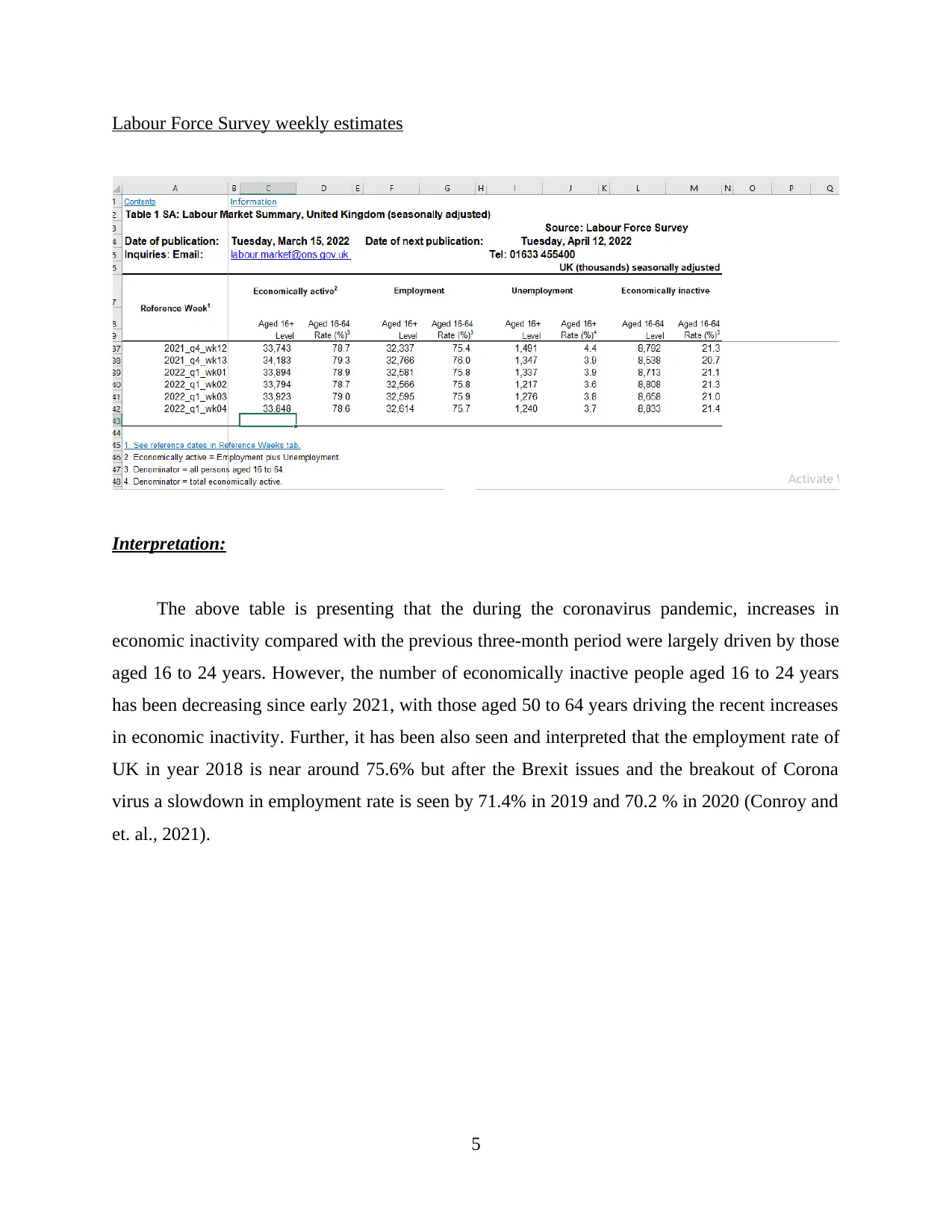
Labour Force Survey weekly estimates
Interpretation:
The above table is presenting that the during the coronavirus pandemic, increases in
economic inactivity compared with the previous three-month period were largely driven by those
aged 16 to 24 years. However, the number of economically inactive people aged 16 to 24 years
has been decreasing since early 2021, with those aged 50 to 64 years driving the recent increases
in economic inactivity. Further, it has been also seen and interpreted that the employment rate of
UK in year 2018 is near around 75.6% but after the Brexit issues and the breakout of Corona
virus a slowdown in employment rate is seen by 71.4% in 2019 and 70.2 % in 2020 (Conroy and
et. al., 2021).
5
Interpretation:
The above table is presenting that the during the coronavirus pandemic, increases in
economic inactivity compared with the previous three-month period were largely driven by those
aged 16 to 24 years. However, the number of economically inactive people aged 16 to 24 years
has been decreasing since early 2021, with those aged 50 to 64 years driving the recent increases
in economic inactivity. Further, it has been also seen and interpreted that the employment rate of
UK in year 2018 is near around 75.6% but after the Brexit issues and the breakout of Corona
virus a slowdown in employment rate is seen by 71.4% in 2019 and 70.2 % in 2020 (Conroy and
et. al., 2021).
5
Paraphrase This Document
Need a fresh take? Get an instant paraphrase of this document with our AI Paraphraser
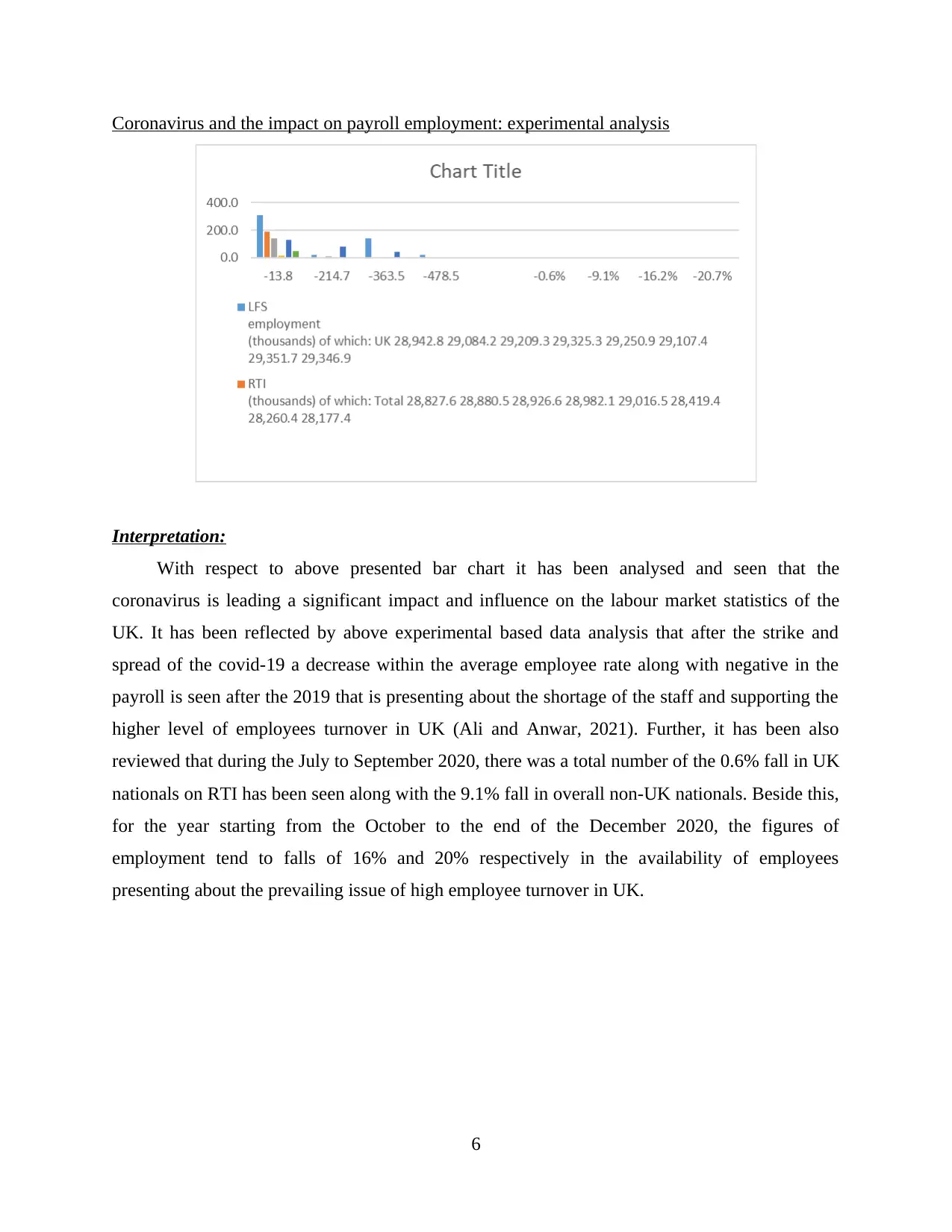
Coronavirus and the impact on payroll employment: experimental analysis
Interpretation:
With respect to above presented bar chart it has been analysed and seen that the
coronavirus is leading a significant impact and influence on the labour market statistics of the
UK. It has been reflected by above experimental based data analysis that after the strike and
spread of the covid-19 a decrease within the average employee rate along with negative in the
payroll is seen after the 2019 that is presenting about the shortage of the staff and supporting the
higher level of employees turnover in UK (Ali and Anwar, 2021). Further, it has been also
reviewed that during the July to September 2020, there was a total number of the 0.6% fall in UK
nationals on RTI has been seen along with the 9.1% fall in overall non-UK nationals. Beside this,
for the year starting from the October to the end of the December 2020, the figures of
employment tend to falls of 16% and 20% respectively in the availability of employees
presenting about the prevailing issue of high employee turnover in UK.
6
Interpretation:
With respect to above presented bar chart it has been analysed and seen that the
coronavirus is leading a significant impact and influence on the labour market statistics of the
UK. It has been reflected by above experimental based data analysis that after the strike and
spread of the covid-19 a decrease within the average employee rate along with negative in the
payroll is seen after the 2019 that is presenting about the shortage of the staff and supporting the
higher level of employees turnover in UK (Ali and Anwar, 2021). Further, it has been also
reviewed that during the July to September 2020, there was a total number of the 0.6% fall in UK
nationals on RTI has been seen along with the 9.1% fall in overall non-UK nationals. Beside this,
for the year starting from the October to the end of the December 2020, the figures of
employment tend to falls of 16% and 20% respectively in the availability of employees
presenting about the prevailing issue of high employee turnover in UK.
6
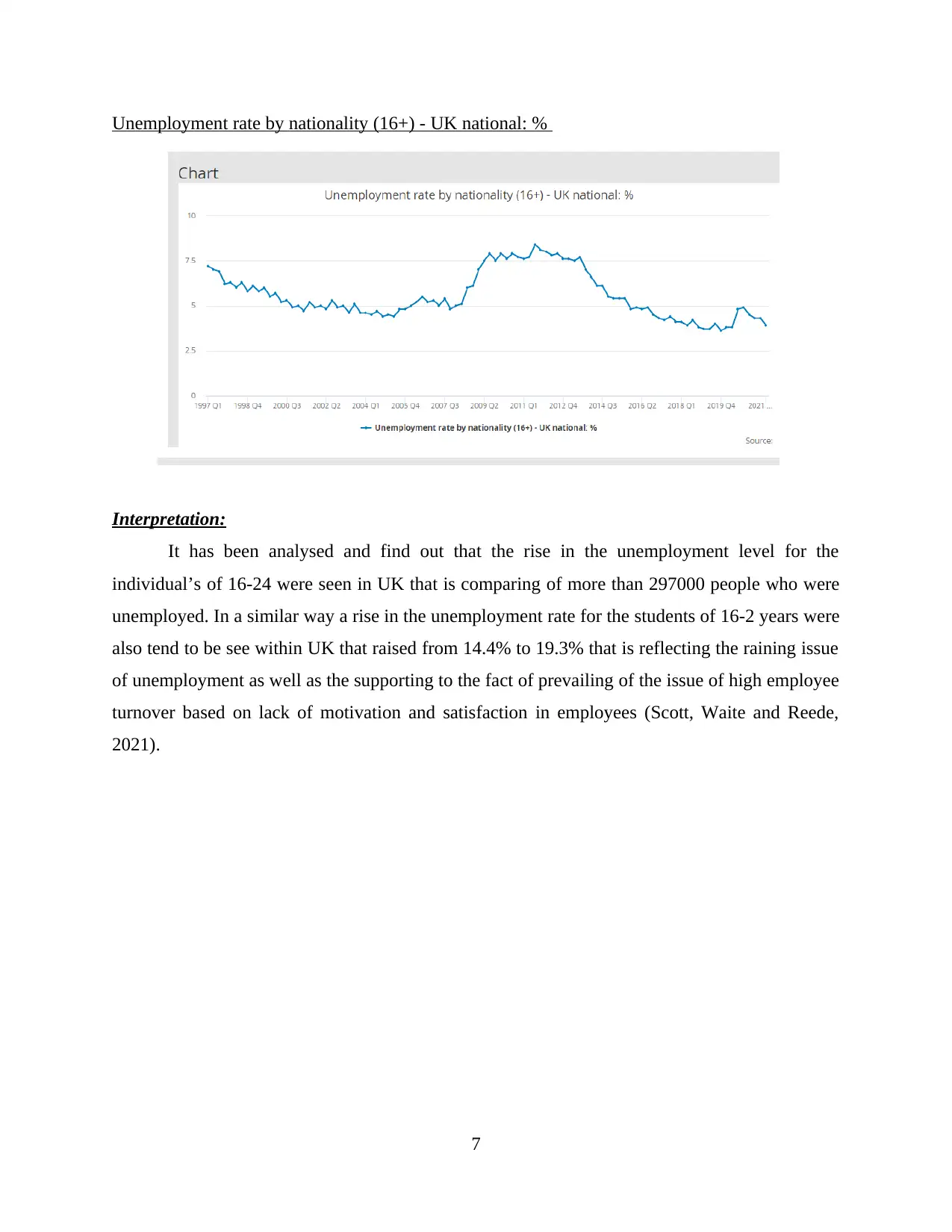
Unemployment rate by nationality (16+) - UK national: %
Interpretation:
It has been analysed and find out that the rise in the unemployment level for the
individual’s of 16-24 were seen in UK that is comparing of more than 297000 people who were
unemployed. In a similar way a rise in the unemployment rate for the students of 16-2 years were
also tend to be see within UK that raised from 14.4% to 19.3% that is reflecting the raining issue
of unemployment as well as the supporting to the fact of prevailing of the issue of high employee
turnover based on lack of motivation and satisfaction in employees (Scott, Waite and Reede,
2021).
7
Interpretation:
It has been analysed and find out that the rise in the unemployment level for the
individual’s of 16-24 were seen in UK that is comparing of more than 297000 people who were
unemployed. In a similar way a rise in the unemployment rate for the students of 16-2 years were
also tend to be see within UK that raised from 14.4% to 19.3% that is reflecting the raining issue
of unemployment as well as the supporting to the fact of prevailing of the issue of high employee
turnover based on lack of motivation and satisfaction in employees (Scott, Waite and Reede,
2021).
7
⊘ This is a preview!⊘
Do you want full access?
Subscribe today to unlock all pages.

Trusted by 1+ million students worldwide
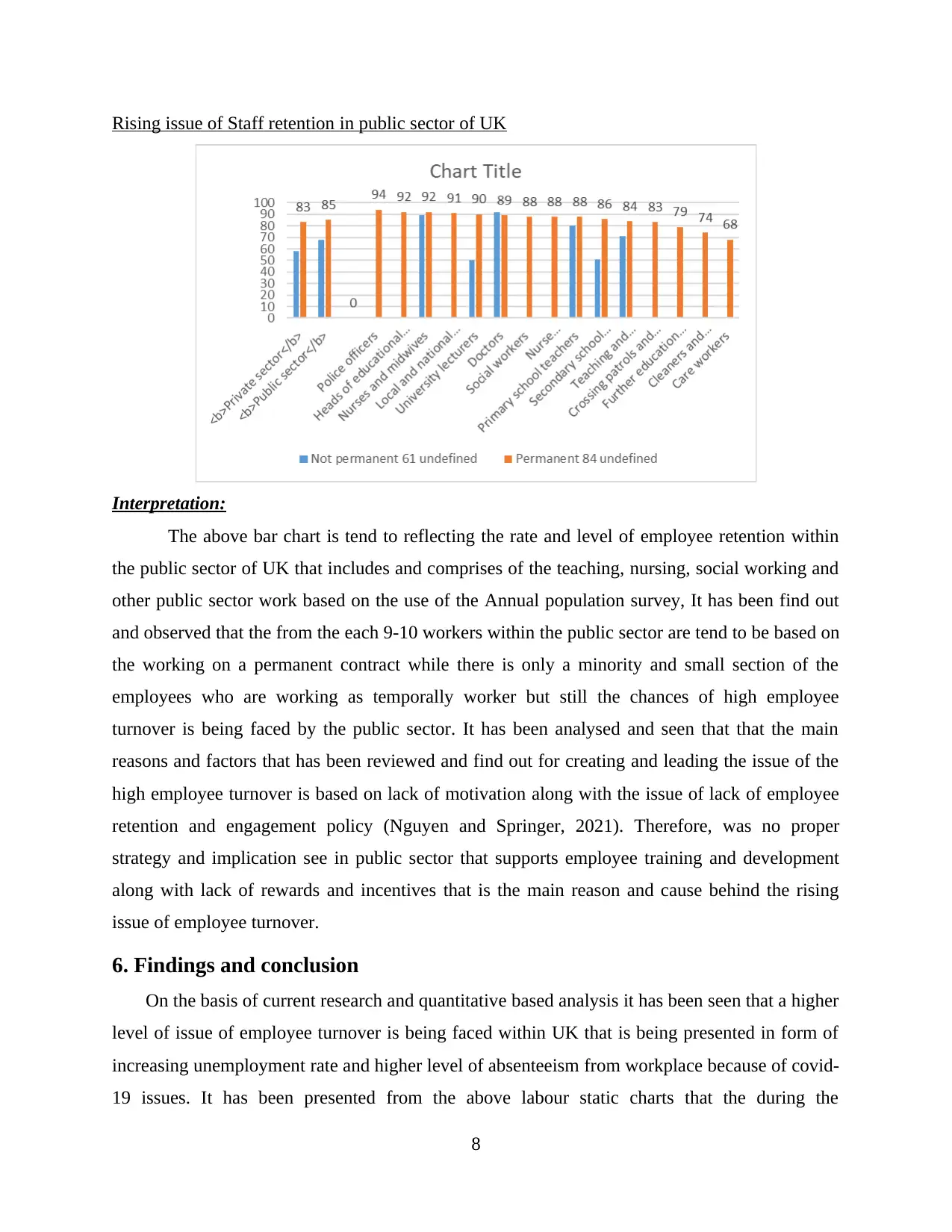
Rising issue of Staff retention in public sector of UK
Interpretation:
The above bar chart is tend to reflecting the rate and level of employee retention within
the public sector of UK that includes and comprises of the teaching, nursing, social working and
other public sector work based on the use of the Annual population survey, It has been find out
and observed that the from the each 9-10 workers within the public sector are tend to be based on
the working on a permanent contract while there is only a minority and small section of the
employees who are working as temporally worker but still the chances of high employee
turnover is being faced by the public sector. It has been analysed and seen that that the main
reasons and factors that has been reviewed and find out for creating and leading the issue of the
high employee turnover is based on lack of motivation along with the issue of lack of employee
retention and engagement policy (Nguyen and Springer, 2021). Therefore, was no proper
strategy and implication see in public sector that supports employee training and development
along with lack of rewards and incentives that is the main reason and cause behind the rising
issue of employee turnover.
6. Findings and conclusion
On the basis of current research and quantitative based analysis it has been seen that a higher
level of issue of employee turnover is being faced within UK that is being presented in form of
increasing unemployment rate and higher level of absenteeism from workplace because of covid-
19 issues. It has been presented from the above labour static charts that the during the
8
Interpretation:
The above bar chart is tend to reflecting the rate and level of employee retention within
the public sector of UK that includes and comprises of the teaching, nursing, social working and
other public sector work based on the use of the Annual population survey, It has been find out
and observed that the from the each 9-10 workers within the public sector are tend to be based on
the working on a permanent contract while there is only a minority and small section of the
employees who are working as temporally worker but still the chances of high employee
turnover is being faced by the public sector. It has been analysed and seen that that the main
reasons and factors that has been reviewed and find out for creating and leading the issue of the
high employee turnover is based on lack of motivation along with the issue of lack of employee
retention and engagement policy (Nguyen and Springer, 2021). Therefore, was no proper
strategy and implication see in public sector that supports employee training and development
along with lack of rewards and incentives that is the main reason and cause behind the rising
issue of employee turnover.
6. Findings and conclusion
On the basis of current research and quantitative based analysis it has been seen that a higher
level of issue of employee turnover is being faced within UK that is being presented in form of
increasing unemployment rate and higher level of absenteeism from workplace because of covid-
19 issues. It has been presented from the above labour static charts that the during the
8
Paraphrase This Document
Need a fresh take? Get an instant paraphrase of this document with our AI Paraphraser
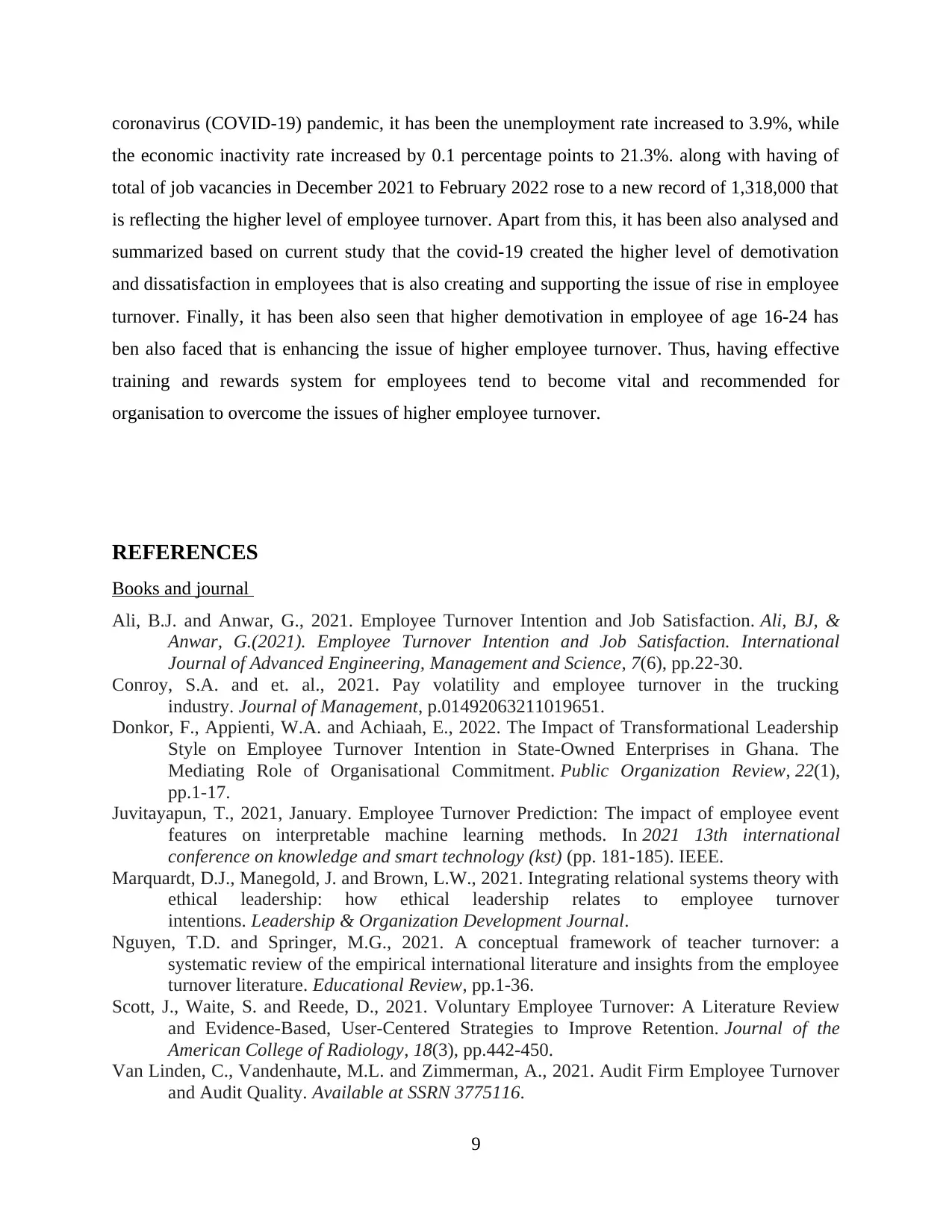
coronavirus (COVID-19) pandemic, it has been the unemployment rate increased to 3.9%, while
the economic inactivity rate increased by 0.1 percentage points to 21.3%. along with having of
total of job vacancies in December 2021 to February 2022 rose to a new record of 1,318,000 that
is reflecting the higher level of employee turnover. Apart from this, it has been also analysed and
summarized based on current study that the covid-19 created the higher level of demotivation
and dissatisfaction in employees that is also creating and supporting the issue of rise in employee
turnover. Finally, it has been also seen that higher demotivation in employee of age 16-24 has
ben also faced that is enhancing the issue of higher employee turnover. Thus, having effective
training and rewards system for employees tend to become vital and recommended for
organisation to overcome the issues of higher employee turnover.
REFERENCES
Books and journal
Ali, B.J. and Anwar, G., 2021. Employee Turnover Intention and Job Satisfaction. Ali, BJ, &
Anwar, G.(2021). Employee Turnover Intention and Job Satisfaction. International
Journal of Advanced Engineering, Management and Science, 7(6), pp.22-30.
Conroy, S.A. and et. al., 2021. Pay volatility and employee turnover in the trucking
industry. Journal of Management, p.01492063211019651.
Donkor, F., Appienti, W.A. and Achiaah, E., 2022. The Impact of Transformational Leadership
Style on Employee Turnover Intention in State-Owned Enterprises in Ghana. The
Mediating Role of Organisational Commitment. Public Organization Review, 22(1),
pp.1-17.
Juvitayapun, T., 2021, January. Employee Turnover Prediction: The impact of employee event
features on interpretable machine learning methods. In 2021 13th international
conference on knowledge and smart technology (kst) (pp. 181-185). IEEE.
Marquardt, D.J., Manegold, J. and Brown, L.W., 2021. Integrating relational systems theory with
ethical leadership: how ethical leadership relates to employee turnover
intentions. Leadership & Organization Development Journal.
Nguyen, T.D. and Springer, M.G., 2021. A conceptual framework of teacher turnover: a
systematic review of the empirical international literature and insights from the employee
turnover literature. Educational Review, pp.1-36.
Scott, J., Waite, S. and Reede, D., 2021. Voluntary Employee Turnover: A Literature Review
and Evidence-Based, User-Centered Strategies to Improve Retention. Journal of the
American College of Radiology, 18(3), pp.442-450.
Van Linden, C., Vandenhaute, M.L. and Zimmerman, A., 2021. Audit Firm Employee Turnover
and Audit Quality. Available at SSRN 3775116.
9
the economic inactivity rate increased by 0.1 percentage points to 21.3%. along with having of
total of job vacancies in December 2021 to February 2022 rose to a new record of 1,318,000 that
is reflecting the higher level of employee turnover. Apart from this, it has been also analysed and
summarized based on current study that the covid-19 created the higher level of demotivation
and dissatisfaction in employees that is also creating and supporting the issue of rise in employee
turnover. Finally, it has been also seen that higher demotivation in employee of age 16-24 has
ben also faced that is enhancing the issue of higher employee turnover. Thus, having effective
training and rewards system for employees tend to become vital and recommended for
organisation to overcome the issues of higher employee turnover.
REFERENCES
Books and journal
Ali, B.J. and Anwar, G., 2021. Employee Turnover Intention and Job Satisfaction. Ali, BJ, &
Anwar, G.(2021). Employee Turnover Intention and Job Satisfaction. International
Journal of Advanced Engineering, Management and Science, 7(6), pp.22-30.
Conroy, S.A. and et. al., 2021. Pay volatility and employee turnover in the trucking
industry. Journal of Management, p.01492063211019651.
Donkor, F., Appienti, W.A. and Achiaah, E., 2022. The Impact of Transformational Leadership
Style on Employee Turnover Intention in State-Owned Enterprises in Ghana. The
Mediating Role of Organisational Commitment. Public Organization Review, 22(1),
pp.1-17.
Juvitayapun, T., 2021, January. Employee Turnover Prediction: The impact of employee event
features on interpretable machine learning methods. In 2021 13th international
conference on knowledge and smart technology (kst) (pp. 181-185). IEEE.
Marquardt, D.J., Manegold, J. and Brown, L.W., 2021. Integrating relational systems theory with
ethical leadership: how ethical leadership relates to employee turnover
intentions. Leadership & Organization Development Journal.
Nguyen, T.D. and Springer, M.G., 2021. A conceptual framework of teacher turnover: a
systematic review of the empirical international literature and insights from the employee
turnover literature. Educational Review, pp.1-36.
Scott, J., Waite, S. and Reede, D., 2021. Voluntary Employee Turnover: A Literature Review
and Evidence-Based, User-Centered Strategies to Improve Retention. Journal of the
American College of Radiology, 18(3), pp.442-450.
Van Linden, C., Vandenhaute, M.L. and Zimmerman, A., 2021. Audit Firm Employee Turnover
and Audit Quality. Available at SSRN 3775116.
9

Wang, X. and Zhi, J., 2021. A machine learning-based analytical framework for employee
turnover prediction. Journal of Management Analytics, 8(3), pp.351-370.
Online:
Main figures: Employment and unemployment rate, 2021. [Online] Available Through:<
https://www.ons.gov.uk/ >.
10
turnover prediction. Journal of Management Analytics, 8(3), pp.351-370.
Online:
Main figures: Employment and unemployment rate, 2021. [Online] Available Through:<
https://www.ons.gov.uk/ >.
10
⊘ This is a preview!⊘
Do you want full access?
Subscribe today to unlock all pages.

Trusted by 1+ million students worldwide
1 out of 12
Related Documents
Your All-in-One AI-Powered Toolkit for Academic Success.
+13062052269
info@desklib.com
Available 24*7 on WhatsApp / Email
![[object Object]](/_next/static/media/star-bottom.7253800d.svg)
Unlock your academic potential
Copyright © 2020–2025 A2Z Services. All Rights Reserved. Developed and managed by ZUCOL.




